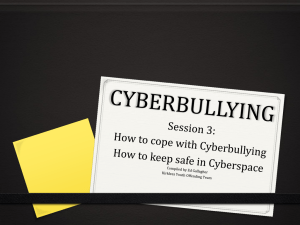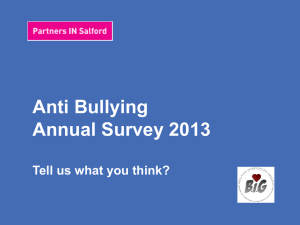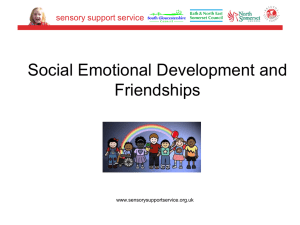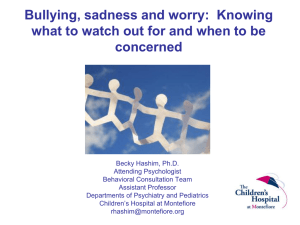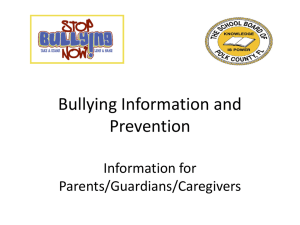Inside out approach to bullying prevention
advertisement
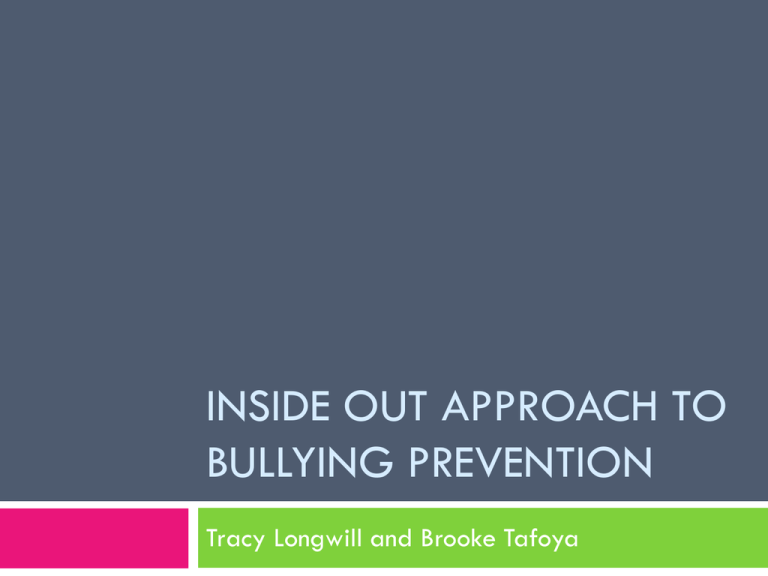
INSIDE OUT APPROACH TO BULLYING PREVENTION Tracy Longwill and Brooke Tafoya Introductions Role Groups Background knowledge and experience in bullying prevention What is bullying? Bullying is aggressive behavior that is intentional and that involves an imbalance of power or strength. Typically, it is repeated over time. Stop Bullying Now! "A person is bullied when he or she is exposed, repeatedly and over time, to negative actions on the part of one or more other persons, and he or she has difficulty defending himself or herself." Olweus Bullying is unfair and one sided behavior. It happens when someone keeps hurting, frightening, threatening, or leaving someone out on purpose, in person or via multi-media. APS and Bernalillo County What is bullying? Bullying can take three forms… • • • • • Hitting Kicking Spitting Pushing Taking personal belongings Physical • • • • Taunting Malicious teasing Name calling Making threats Verbal • Spreading rumors • Manipulating social relationships • Engaging in social exclusion • Extortion or intimidation Psychological Which is easiest to see? Which causes the most harm? Which do your current rules address? What is bullying? Key Components Imbalance of power: Involved parties feel differently about the outcome Target feels scared, afraid, or hurt Aggressor feels empowered or unconcerned Happens over a period of time Bullying is NOT A conflict to be mediated. This sends the message that both parties are responsible Rite of passage or a normal part of growing up Harmless fun About anger Differences between conflict and bullying NORMAL CONFLICT BULLYING Equal power – friends Imbalance of power – not friends Happens occasionally Repeated negative actions Accidental Purposeful Not serious Serious – threat of physical harm or emotional or psychological hurt Equal emotional reaction Strong emotional reaction on part of the target Not seeking power or attention Seeking power and control Not trying to get something Trying to gain material things or power Remorse – takes responsibility No remorse – blames target Effort to solve the problem No effort to solve the problem Stand Up Exercise Stand if you have had experience with any of the statements read •When you stood how did it make you feel? •Was there anything surprising? What is bullying? Aggressor 10-15% Bullying Event Bystander 85% Target 10-15% Acts of Extreme Violence • Genocide, Terrorism, Murder, Arson Violence Discrimination Acts of Prejudice and Bigotry Acts of Bias • • • • Assault & Battery Dehumanization Vandalism Threats • Social exclusion or Harassment • Discrimination: employment, housing, educational • Scapegoating, Slurs, Namecalling, Social Avoidance • Engaging in Stereotypes • Screening out positive information. Activities Where do you fit? Card exercise Man box and Lady box Implications of Being Bullied I shall remember forever and will never forget Monday: my money was taken. Tuesday: names called. Wednesday: my uniform torn. Thursday: my body pouring with blood. Friday: it’s ended. Saturday: freedom. The final diary pages of thirteen-year old Vijay Singh. He was found hanging from the banister rail at home on Sunday. Bullycide, Death at Playtime: An Expose of Child Suicide Caused by Bullying. Neil Marr and Tim Field What New Mexico Youth Tell Us 2009 New Mexico Youth Risk and Resiliency Survey E:\YRRS 2009.pdf Activities Where do you fit? Card exercise Ice Breaker Builds empathy/knowledge Addresses peer pressure Address traditional roles and try something new Man box and Lady box Addresses gender stereotypes Pressure expected gender roles can place on a person TIPS to Stop Bullying for Youth • Keep yourself safe. NEVER put yourself in a situation where you could get hurt • Get help. Tell a trusted adult if you see someone in trouble. • Support by offering to help them pick up their books, take them to someone who can help, there is power in numbers, just stand beside the person, ask other friends to support the person). • Support the target by asking them to join in an activity with you (let’s go…, do you want to go get a drink of water?). • Distract Tell the aggressor you don’t like talking about people or change the subject. • Support the person who is being bullied by changing the subject to something other than talking about or hurting someone (Did you bring your lunch today?, Wow, look at that…, Watch out here comes a teacher) • Reason with the aggressor, “You might get into trouble, if you keep bothering that person” or “you might get kicked off the basketball team and we really need you.” What Should Caring Adults Do GUIDE and SUPPORT Listen Brainstorm possible actions and consequences Encourage, rather than direct Let youth decide the course of action TIPS for Parents Focus on your child. Be supportive, listen and gather information about the incident. Never tell your child to ignore bullying. What the child may “hear” is that you are going to ignore it. If your child were able to simply ignore it, he or she likely would not have told you about it. Often, trying to ignore bullying allows it to become more serious. Contact your child’s teacher or principal to report bullying and to find out about the school’s bullying prevention plan. Keep your emotions in check. Give factual information about your child’s experience of being bullied, including who, what, when, where and how. Help your child become more resilient. Talk to your child about being friends with certain people and knowing which friends he or she can count on. Encourage positive relationships by encouraging your child to hang out with kids that make them feel good about themselves. TIPS for Adults in Creating a Culture of Respect Adults know less about bullying situations than youth do. Identify, teach and re-teach expected pro-social behaviors through role play and practice. Here are some recommended rules: • We will not bully others. • We will try to help students who are bullied. • We will make it a point to include students who are easily left out. • If we know someone is being bullied, we will tell an adult. (Olweus) Create a Culture of Respect Every adult needs to be able to intervene quickly & follow up with each party. Use information from questionnaire to identify areas in need of attention. Integrate themes into every activity. Best Practice Tips for Investigating a Bullying Incident Talk with each party separately Affirm the child’s feelings Ask Questions: Get information about the current situation and the history of the situation. Identify what has and has not worked in the past. Generate solutions for the future, and create a plan with the child. Discuss how the child can avoid the student in the future Coach the student in using assertive refusal skills Identify others who can support the child Follow-Up See how the plan is working Contact parents as appropriate Refer more serious or chronic cases to an administrator or counselor Why is Cyber-bullying Unique? How does cyber-bullying compare to traditional bullying? Can not see the target’s emotional reaction Can happen at any time Distributed quickly to a wide audience Anonymity Framing the Issue Why is anonymous aggression different? Anonymity People effects the content of the message act differently when they are not accountable for their actions Do not have to see person’s pain Anonymity effects the way the message is received Target has no way to know if it is a group or an individual Known enemies are less frightening than unknown Can change relationships with multiple suspected friends Kowalski and Limber (2007). Electronic Bullying Among Middle School Students. Journ of Adol Health 41. S22-S30 Cyberbullying in the United States 93% of adolescents have access to the internet through computer or cell phone use 1 in 3 children has been bullied online by someone they know 1 in 3 has been bullied while playing an online game 1 in 2 have been bullied by cell phone Almost half have been bullied on the social networking site, Facebook 13% of teens have received naked or semi-naked images from someone in school 8% have sent them Dr. Sameer Hinduja- Co-Director of the Cyberbullying Research Center of Florida Altantic University, 2010 Effects of Cyberbullying Negative Emotions Anger Sadness Hurt feelings Embarrassed Afraid Negative Behaviors Poor concentration Low school achievement Absenteeism from school Retaliatory anti-social behavior Help Young People Navigate Technology Netiquette Behavior online should be the same as what you would do in person. If your grandma could see what you do online, would you do it? Would it be okay if I did this in a face-to-face interaction? How does this action reflect on me? Adults can model appropriate interactions with technology for young people Help Young People Navigate Technology Coping Skills Responding with anger shows that someone has hurt or done something that bothers you Tell them to stop Instead of focusing on all of the people who seem to be against you, focus on those who care and support you Consequences Cyber-foot prints Legal ramifications of cyber threats YouTube as evidence Resource Alex Wonder Kid Cyber Detective Agency www.stopcyberbullying.org E:\Alex_WonderV1.1.air Cyber-bullying Youth Tips Don’t initiate, respond to, or forward harmful messages If something mean is posted or texted about you, don’t respond immediately, take a breath and give yourself time to think through your next step. Don’t react immediately. Keep intimate and personal info- private Think about your reputation- would you want— grandma, teacher, future employer, someone you don’t know—to see that? If you feel uncomfortable, trust your gut, save and tell an adult Don’t meet unknown internet friends without talking to your parents or another adult about it Cyber-bullying School Tips Teach social skills - much of the same work that is done for bullying is relevant to this work, but online education should be added to bullying prevention curriculums Develop a needs assessment to better understand the problem from students’ and teachers’ perspectives Conduct a policy and practice review…if you don’t have policies, develop them Provide annual professional development about technology, youth development, and bullying prevention Inform youth about legal limits Cyber-bullying Parent Tips Ask your child questions, maintain an open dialogue. Keep computer in a common room. Talk about your expectations regarding acceptable online/phone behavior before they receive the privilege. Behavior online should be the same as what you would do in person or in front of someone you respect. Make agreements and set boundaries about accepted use and behavior for online/phone communication. Often youth don’t tell parents because they fear losing technology privileges. Help child think through how the information they put online reflects on them. Inform youth about legal limits and future consequences of harmful posting online or by phone. Ask your child to teach you about programs and technologies you don’t understand or of which you don’t have familiarity. What is APS doing? District-wide Discipline/Bullying Prevention Plan Safe School Healthy Students Initiative Bullying Prevention Campaign Funding for Prevention service Brochure for Parents Materials and Training Website www.abqsafeschools.org PBIS 25 Schools What is APS doing? Prevention Programs Steps to Respect Second Step Rachel’s Challenge Safe School Ambassadors Why Try? Contact Information Tracy Longwill, APS Safety Resource Counselor longwill@aps.edu, Brooke 505-855-9835 Tafoya, SSHS Coordinator brooke.tafoya@aps.edu, 505-855-9812 Find resources and handouts at: www.abqsafeschools.org Tips, Power Point and Resources Resource List Books: Bullyproof Your Child for Life. Joel Haber. *2007). The Bully, the Bullied & the Bystander. Barbara Coloroso. (2008). Cyberbullying: What Counselors Need to Know. Sheri Bauman. (2011). Cyberbullying and Cyberthreats. Nancy E. Willard. (2007). Websites: www.pta.org/bully.asp www.bullying.org www.cyberbullying.org www.stopbullying.gov (English or Spanish) www.ParentsConnect.com www.parentsagainstbullying.com www.bullyproofkids.com www.netsmartz.org Resource List continued www.stopbullyingnow.com www.stopcyberbullying.org www.cybersafe.ws http://cybersmartcurriculum.org/safetysecurity/lessons/www.youtube.com/watch?v =A-9PXsmGHTw&feature=PlayList&p=3A2A5391F175757B&playnext= 1&playnext_from=PL&index=16 www.bullyinginfo.org http://cyberbullying.us/ www.stopcyberbullying.org/index2.html Alex Wonder Kid Cyber Detective Agency ConnectSafely http://www.connectsafely.org ConnectSafely—Spanish http://www.connectsafely.org/Espa%C3%B1ol (resources for Spanish-speaking families) A Final Thought Cowardice asks the question: is it safe? Expediency asks the question: is it politic? Vanity asks the question: is it popular? But conscience asks the question: is it right? And there comes a time when one must take a position that is neither safe, nor politic, nor popular-but one must take it because it’s right. -Martin Luther King Jr.


